Montour Railroad
Mileposts
Bridges
History
Maps
Roster
Mines
Links
Gallery
Working on the
Montour
Schaeffer
Stories
Sposato
Stories
Employees
Railroading
101

|
|
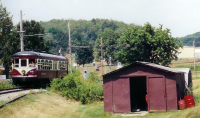
|
Tool Shanty
The tool shanty's were removed in March of 1983 by several Museum
volunteers and myself, some place I have some photos of the dismantling
of both shanty's. When I locate them you can have a start to
finish story. We did want to have both reconstructed
at the Museum, but the MRR Jct. shed had more deterioration along the
base than Cowden's, we elected to make one shed using the
best pieces. Naturally all remaining tools, track
components and some switch lamp parts were loaded up also.
The coal stoves had been removed quite sometime prior, but a few odd
pieces were still around, I know they made it to the Museum also.
We used a flatbed truck from a Washington Pa. area contractor that was
donated on the days we needed to haul.
We did have a great time taking them down, especially the Cowden
one. It was a few car lengths off a private dirt crossing against
the main track, but the main was full of P&LE stored boxcars at the
time, so dismantling and loading was more of a challenge. Naturally the
weather was typical; rain, sleet, cold and disagreeable.
This photo was taken August 2004, when we ran the passenger
excursions on the P&OC to Arden. I spoke with some board
members then and there were no plans to discontinue its use at
that time. Also attached is the release I signed from the MRR and witnessed by the 2nd (P&LE) Superintent (RJCostello) of the MRR.
|
 | Montour #73
This
winter (2014) has been similar to those winters of the 1970s that I
recall. In going through a few boxes in search of a photo I need, I
came across this picture from about 40 years back....40 years....geez.
As
a teenager I can't help but to marvel at how Railroad Men of the
Montour permitted us youngsters to enjoy what they considered a routine
job....why did we prefer to spend time with them at work rather than
being out sled riding, ice skating or chasing the girls. They didn't
understand, but they tolerated us.
Looking back, little did I
know riding those cold, drafty, SW9 cabs would shape my future. Those
days of naive innocence can never be replicated in today's world of
railroading. Even though looking at this grainy Instamatic photo
has not the quality of today's digital views, the power is there,
captured for eternity to be found by generations of rail enthusiast's
not yet discovered nor born of this world. Close your eyes and ride
along as the #73 gently sways back and forth on yet another eastbound
Trip to Mifflin Jct. on this snowy February day…….and reminisce.
| 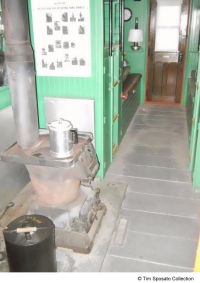 | Caboose Coffee
When
I poured myself a cup of “Joe” from the percolator coffee pot in the
round house lunchroom recently, I had a memory flashback of the many
cups of java I enjoyed while employed on the MRR. I had
been a coffee drinker since I was quite young; “weaned on coffee” is
what I have told many people. Those Montour days fine tuned my
taste buds to many types and ways to drink this dark brew.
As a
youngster getting rides on the eastbound coal runs to Mifflin, we felt
pretty mature getting a steaming cup from the generous rear end crews
that allowed us to ride along. Sometime a slice of pie was offered
as well. Montour Junction had several locations to get a cup. The main
office had their pot, shared by all on the second floor, including the
dispatcher. Below them the store keeper had his pot nearby, again,
shared by the engine house foreman and others as well. The engine
house had several pots scattered about, some percolators, some coal
stove pots…next to the weld shop, break room or the airbrake shop. And
don’t forget the car knockers, two pots there, one in the break room
and the other in the foreman’s office. Regardless where one stopped by
at the Junction and poured a cup, they could be assured of a good brew.
Working
2nd trick Yardmaster at Champion, I got used to stepping into the
trainman’s room to the aroma of strong coffee. As long as a
crew or Yardmaster was on duty, so was the electric percolator coffee
pot, note, not a drip or quick brewer, but a true device to make good
java. When I walked down to the tipple and entered the shipper’s office
overlooking the loaded yard, one could be assured to get some “Consol
Coffee” as well; again a percolator pot was always on. Working the
Champion desk, I recall rarely seeing the bottom of my thick porcelain
mug. Seemed that when the coffee got low and cold in it, I would stroll
to the trainman’s side and fill ‘er up again. This procedure
would happen countless times in my 8 hour shift.
The Coal Runs
when arriving west bound at Champion Yard would cut the caboose off on
the main track across from the Yard office. The Conductor would amble
over to deliver the waybills so I could compare the bills to the loads
as they were shoved up to the dumper. Sometimes after this shove
was completed I would walk back to the caboose with the Con and chat
for a while. Winter or summer, coffee could be found on the
caboose stove, maybe warm or hot….strong or weak, it was there.
Each caboose was furnished with coffee fixings, or not. Some had
cream, some had sugar, some had both, and others had none.
No matter I learned to accept my “Joe” whatever way it was offered to
me.
Caboose stove coffee was by far the best, one can’t beat the
coal smoke, coffee and oil aroma of a caboose. The heavy white
mugs in the caboose were cleaned and stored with a wadded up paper
towel stuffed into to it, keeping out the coal dust that surrounded its
environment. I still store my mug the same way to this day at the
roundhouse……old habit……
This memory might mean very little to
those that don’t drink coffee or have never experienced how railroaders
excelled in coffee preparation, but it is yet another small piece to
the rich history that is overlooked as we tend to focus in more common
areas of Montour RR’s colorful past. | 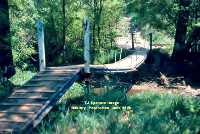 | Library Foot Bridge
The
Library foot bridge was one of several MRR owned and maintained
conveniences for the public and or landowners, when arrangements were
made during construction of the railroad that interfered
with their access to properties. Other bridges that come to mind
would have been the overhead bridge west of Brookside, Broughton Rd,
Brush Run Rd, swinging bridge over Kamp's Cut and another swinging
bridge over Montour Run Creek around MP 3.5 to name a few.
All
these bridges had the same thing in common, owned and maintained by the
MRR. Section #2 trackmen would be responsible for repairs to the
Library foot bridge bridge as needed. I remember replacing planking on
several occasions, removing a fallen tree off its approach and
shoveling snow off of it as well in winter months.
The general
construction of these swing bridges were made up of two strands of
rails stretching across the creek, supported by vertical rails or pipes
on each side at the abutments. The strands of rails then had wooden
planking like those used on trestle walkways fitted between the rails.
The rails were “gauged” with threaded rods that maintained the width
between them and to hold the planking in place with an occasional bolts
into cross members. This assembly was then supported by cables
stretching across that also served as handholds.
This
foot bridge lasted into the nineties to serve the public to access the
trolley stop, the Port Authority Transit did repair it up until the
arrival of the Light Rail Vehicle fleet that prompted the retirement of
the trolley stop under the Viaduct. I frequented this stop quite
often when trying to get back home after riding the train from
Mifflin to #10 mine, that is if I had enough coins in my pocket, if not
it was a good hike home or maybe a thumb ride most of the way. Not sure
who dismantled the bridge , but I'm sure it was in a bad state of
disrepair by then.
The local kids would hang out there drinking
and partying based on the many bottles, cans and other unmentionable
items that littered the area. The picture attached is looking towards
the trolley tracks, the trestle work of the Viaduct is visible on the
photo edges. Route 88 is behind me. The remnants of the steps up the
hillside can still be see as well as what’s left of the trolley stop
platform area today. Note the rail joint in the bridges center
since the creek was rather wide here to require the extra rail length. | 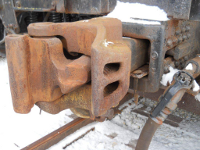 | Hi-Lo's
Several
weeks ago, someone mentioned a train having an undesired
uncoupling while on the road. The term, high-low, referred to the
coupler height matchup between any of the cars/caboose/ engines in the
consist. If one of the couplers was considerably lower than the other,
a potential “hi-lo” existed. The causes for a low hanging coupler was
generally from hard coupling impacts while being loaded at
the mine. I recall hearing many hard impacts echoing in the valley at
#4 mine , all hours of the day and night. Single cars or cut of
cars dropped by the car dropper might get away account of a bad order
hand brake or an ill timed use of the hand brakes. Sometimes it
may have been several impacts or just a gradual debilitating
operating condition that would eventually result in the hi-lo condition.
The
defect was different depending on the cars design. The term
‘carrier iron” was from the earlier days of railroading. Majority of
cars after the turn of the century were equipped with fabricated,
riveted steel or cast steel carriers. These may have been a solid
casting that the coupler past through to mate up with the draft gear
assembly, or it could be designed to have the coupler and draft
assembled as one and lifted up into position. This technique
would require bolts to hold the carrier in place to support the
coupler and allow the shank to rest on. Once this hi-lo was in
place and no one on the train crew spotted it during the train build
up, it would only take some rough track with low joints to cause the
uncoupling. The cars rocking combined with a lower that
desired rail joint would permit the low knuckle to slip out of the grip
of its companion, causing separation and then parting of air
hoses thus bring the train to an emergency stop.
Henderson Hill
was a common location for hi-lo’s prior to the newer rail being
installed. Train crews would try to re-couple and go, hoping no more
low joints were ahead or they used the tie plate trick by sliding
the plate between the carrier and coupler, holding it in place with the
use of spikes dropped through the plates spike holes. If the carrier
was too badly damaged, then the dispatcher was notified to change their
train orders allowing them to move a front portion of the train to
Cowden siding for set off near the road crossing for the car knockers
to come repair later. The engines would then return light to retrieve
the rear section and doubling the train together once they reached
Cowden again. This only worked if the bad carrier was on the east
end of the car, if on the west end a chain coupling would be used to
move the car. Both of these methods were time consuming and
costlier in crew hours and delays.
Hi-lo’s could originate from
any mine or location, but generally didn’t expose themselves until on a
hard, uphill pull on rough rack. Trains from #10 mine would be
shoved out to the main and rolled downhill to #4 Mine Hills, so its
hi-lo’s would appear on Henderson Hill thus making this Hill the most
notorious for the higher percentage of these to occur. They did
occasionally occur at other locations as well. Westland had its share
with the cars being set out at the west end of Morris Mine spur track
for repair.
Wet weather, regardless of seasons, increased
the low joint syndrome. Winter months ground was too frozen to
effectively raise and tamp low joints. In this case the spikes would be
removed in both directions of the joint, distance depended on situation
at hand. After the rail was leveled, predrilled plywood or oak
blocks slightly larger than the plate would be placed on the ties and
then the tie plate tapped back under the rail. Extra long spikes used
in certain bridge decking would be spiked through the ‘shims’ and
hopefully get a decent bite into the tie. On occasion if the shim stack
was too thick, half the shims would be spiked to the tie then the other
shims/plate spiked to the lower shims using the longer
spikes……not a good design, but enough to allow trains to pass until a
more permanent repair could be done.
In summary, hi-lo’s were
common of the Montour, but not near so on the majority of railroads.
This is just another uniqueness that we got to see on the Mighty
“M”, adding to the legend of its rich history. The photos show a
recreation of a hi-lo repair using the MRR #815 hopper with the cast
steel striker. This was a good carrier iron, so the coupler is
higher than normal once I inserted the plate and spikes. For
authenticity, I used original MRR spikes and tie plate.
 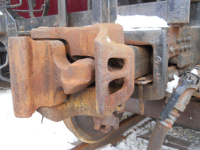 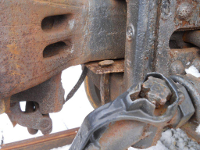 |
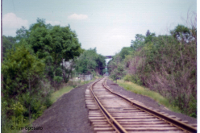
|
Alleco
It
was a warm summer day when we were riding our bikes and
stopped
at Hillcrest Shopping center for a soda. Naturally
most of
our bike rides involved some railroad in the neighborhood. I was armed
with the infamous 110 camera. Easy to slip in a pocket, cheap to
operate.
The shopping center is just to the left,below
the grade, this view looking east crosses RT 88, just as the
straight-a-waystarts. The chain link fence on the left is
what
was known as Alleco, short for Allegheny County, which is the county
owned facility. The "whistle post" is seen on the right, just
a
piece of rail stuck into the ground with a metal plate bent around the
top of it. Stenciled in yellow was the word "signal". This
was
the eastbound approach for the Horning Rd. crossing circuit.
The
bridge over the MRR is Broughton Rd. I recall
watching for
this bridge as I grew up in the sixties when we went to visit
relations on Sunday's, always looking down, hoping to see a train. The
track structure has been left to slowly run down from lack of
maintenance since traffic had dropped off through the 50's &
60's. The inside 90lb rails are "straight-lining"
from deteriorated ties, worn plates and bent spikes. The ties
are
bleached white as most of the creosote has long since vanished.
Occasionally dates nails were found on this line to Salida, lots from
the 30's.
The cinder roadbed was a common sight,
sometimes fragments of fire brick from the steam locomotives were mixed
in with these cinders. Ballast usually marked derailment
locations, one was just behind this photo around 10 car lengths or so,
complete with remnants of the spilled coal today, or more recent other
repairs. This view is hard to see today, the concrete arch underpass
for RT 88 has been "daylighted" , the cut has been filled in
were
the bridge had crossed. Alleco still remains.
Weeds, brush and trash have replaced whats left of this little piece of
right-a-way.
|
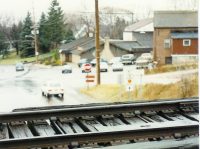
|
Als' Cafe - Jewell
Jewell
Siding and Al's Cafe , like bread & butter, they both fit well
together. The nights of waiting for the eastbound in the old
automobile behind Al's. Watching the patrons come out at closing time
was always entertaining. This helped pass the time as we waited for our
train to arrive. Al's was more of the local sports type lounge in the
1970's & 80's. As I had mentioned in earlier posts,
the MRR
men made many stops here for the great fish sandwiches and
beverages! The Al's new image is geared
toward family
entertainment today and fish is still as good!!
Hearing
the SW9's laboring upgrade from Thompsonville around 2:00am as we
waited, guessing its location as the sounds changed when the drag
passed through cuts or behind the rolling hills, we had it down to the
mile posts. The thrill of seeing the headlight illuminate the
light fog or the tree tops long before we saw the source. By
this
time we had made our way to the switch, our lanterns
lit. We
had boarded here so often over the years that it didn't matter that
there were no loads to be picked up at Jewell, the train slowed enough
for us to swing aboard. It helped that we had also called the
dispatcher earlier, asking if a Coal Run had been called for the
Mifflin Turn. If the reply was "yes" we would
inform him
that we would check the switch to insure it was lined for its movement.
His response "you kids better be careful out there"......
To this day I believe that the DS would casually mention this to the
crew, thus allowing the "flag stop" to occur.
This
picture was taken in 1981, just a few years before the rails were
removed. The local kids had made sure the catwalk and railing
had
been removed, sometimes dropped to road below. I stood on the
siding girders to capture Al's Cafe as it looked at the
time. The rails black with rust now. Also the old
farm house
is seen where the parking lot is now. The old garage that
housed the auto we hid in was to the right, out of the frame, against
the tree line. This dreary, damp day has captured a foreboding look at
the loss that is soon to take place here. Today a small portion of the
top of westend abutment is visible, the road slices it way through the
R of W east of the bridge location. Its nice to stand on this
abutment when I stop by and remember the view pictured here,
remembering the happier times...........
|
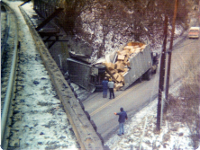 |
Jewell Bridge vs Tractor Trailer
The
Jewell bridge was dislodged from a high truck passing underneath. I
remember a weekend morning callout around 1975. The
story
is about a trucker taking a short cut passed #4 Mine Hills, while
moving items from one warehouse to another. Well as you can
see
he must of missed the height signs or forgot to check his equipment
dimensions. The driver is wearing the "in style, knitted cap".
I
was facing west on the bridge near the loaded yard switch. (note the
nice shine to the railhead!) Needless to say the bridge was the victor
in this encounter, no damage. Oh yes, those boxes in the
container included TV's and an assortment of other household
appliances. We tryed, but didn't get any of the spoils.
Please forgive the quality of the photo, once again the trusty 110
camera I carried in my helmet liner was used. |
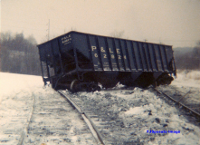 |
Libarary Junction Snow 1977
This
story recalls the problems associated with winter time
railroading. This particular event was after a fresh snow of
several inches on a blustery, overcast and windy day for those that can
remember how it would howl up the valley at Library Jct. As
you may recall, loads would be shoved upgrade ahead of the SW9s
on the Library Branch. The branch was many a scene of
derailments, large and small. This particular day on Feb. 1, 1977
was one of the larger ones.
As the train was
nearing the inside Wye switch, a wheel set dropped between the rails on
wide gauge, the following loads followed suit. The derailed wheels
hit the switch points at the switch causing the P&LE 62824 to
"split" the switch, so now the loads started down the West Wye track,
to the left in the picture. True, this was the shorter way westbound
off the branch, but not the correct way. The angle of the cars
was to much for the air hoses which then parted, dumping the train into
emergency.
The picture was taken after the rear cars were
rerailed and the rear of the train and engines used the siding to get
back to the main track. The siding had to be inspected first because of
the infrequent use it had seen, and the movement was made at less than
walking speed. This inspection was a ordeal in its self because the
snow made visual inspection impossible. Wished there had been more
shovels available that day as we had to clean off the entire siding,
adding gauge rods and spikes as required.
As the picture
shows we had started cleaning out the rail and ties in preparation to
regauging as seen by the spike mauls leaning against the
rails. The west leg rails have not been worked yet. Between the
tracks just off the end of the ties is the scar in the cinders where a
load had been pulled back to the switch for rerailing. The
branch to Library was reopened the following day, the West Wye remained
out of service for a while longer.
|
|
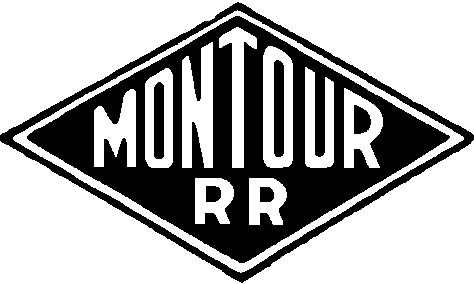 Montour
Railroad
Montour
Railroad 